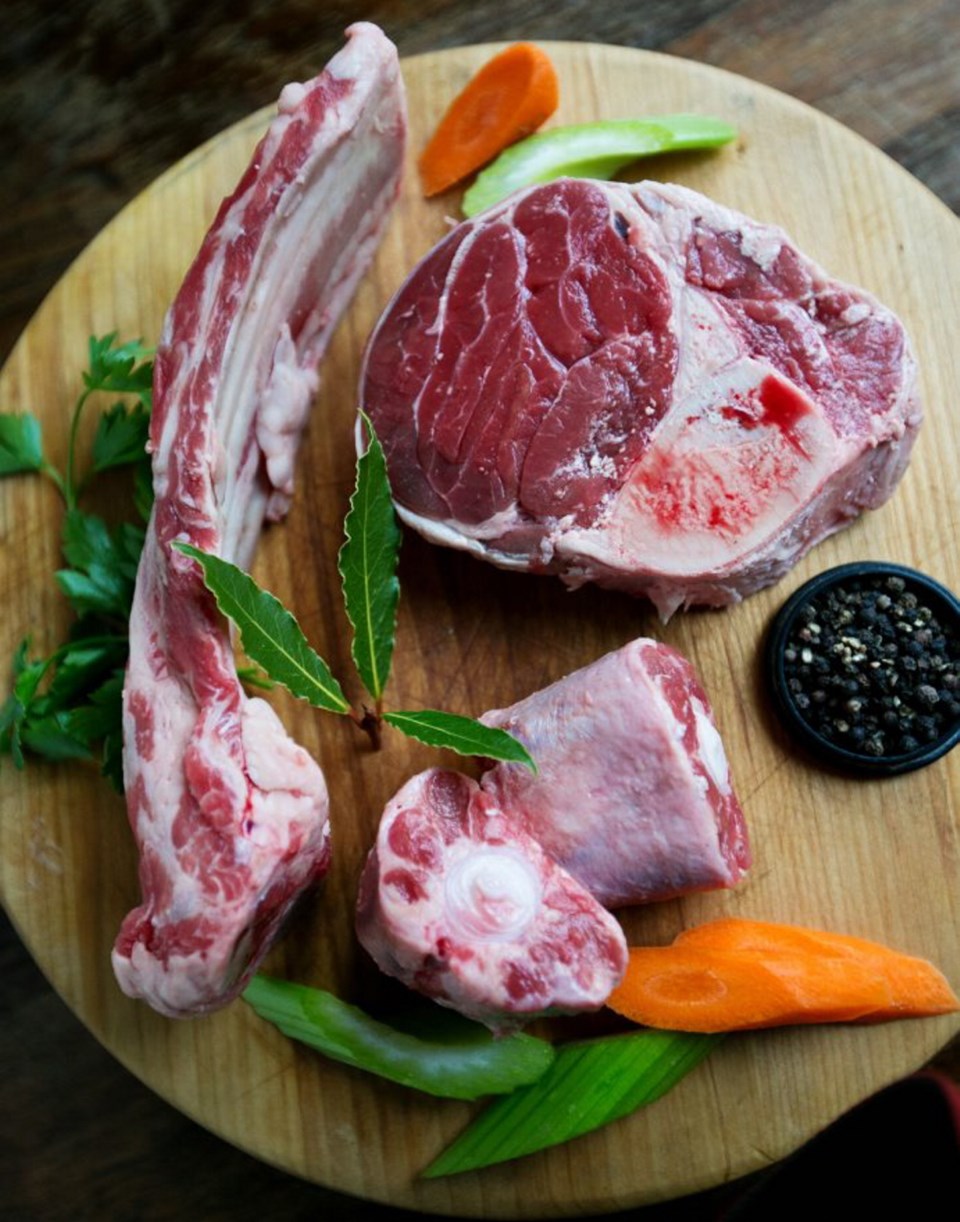 Dear Eric: Have you ever done a column on bone broth? I’ve heard it has health benefits and it’s having a bit of a moment in places like New York, where you can buy it at takeout windows to sip out of coffee cups. Also, I’d be interested in whether you have to adjust recipes if you’re using it instead of store-bought stock.
Dear Eric: Have you ever done a column on bone broth? I’ve heard it has health benefits and it’s having a bit of a moment in places like New York, where you can buy it at takeout windows to sip out of coffee cups. Also, I’d be interested in whether you have to adjust recipes if you’re using it instead of store-bought stock.
Alison
Dear Alison: New York City is where many North American food trends begin and Alison, you’re right, bone broth, also called by the Italian term brodo, is simmering there right now.
Folks are lining up to buy it hot at eateries, or buying it to heat at home. And to prove how trendy it is, on Saturday New York’s Broth Fest was held, with some of the city’s best bone-broth makers gathered to serve up shots of it for patrons.
Bone broth differs from stock or regular broth in that it simmers for a much longer time. Although bones are used to make stock, the ones used for bone broth have some meat still attached to them, such as beef shank or knuckle. Other cuts of meat or poultry that are bony or tough, such as short ribs, oxtail and turkey wings, or whole birds, such as stewing hens, are also used to make bone broth. The taste of these items is complemented during simmering with vegetables, herbs and spices.
I’ve read that bone broth is so popular partly because it’s part of the trendy Paleo diet. That diet guides one to eat as our caveman ancestors did, and foods made with meat and bones certainly qualify.
Cavemen, of course, would not have had the equipment required to make broth, but in Europe, this type of liquid has been prepared for centuries, and its nourishing qualities are another reason why it has become popular again.
As the collagen-rich meat and bones used to make the broth slowly simmer and become so soft they almost crumble, their gelatin, protein, vitamins and minerals release into the liquid. Once strained, bone broth is something healthy to sip, but its concentrated flavour also makes it delicious, a comfort food really, that’s fabulous to enjoy on its own.
At trendy New York broth joints, you can enjoy it that way or you can have your bone broth enhanced with a splash of another health-promoting ingredient, such as ginger juice, freshly grated turmeric or fermented beet juice.
Bone broth can also be used as the base for another dish, such as stew or soup. Perhaps the most famous of the latter is tortellini in brodo, a classic Italian soup with stuffed pasta and a few other simple ingredients added to the broth.
When using bone broth in place of store-bought stock in recipes, remember that it will add a much more intense flavour and will become even more intense if further cooked. If the dish you are making is meant to be more light and delicate tasting, the bold-tasting bone broth would not be well suited for it.
In a restaurant setting, where dozen of litres of bone broth are made in a giant steam kettle, they can simmer for up to 24 hours. In a smaller-batch, home setting, though, the recipes I found for bone broth simmered for about six to 12 hours, depending on the ingredients used.
Because of the size of the meaty bones I used in my recipe, my broth required that shorter six hours. After it had cooled and I had refrigerated it, I knew good things had come out of those bones beause the liquid had become completely jelled.
Rich and Flavourful Three Beef Bone Broth
Beef back ribs, shank and oxtails flavour this rich, delicious and nutritious broth.
Preparation time: 30 minutes, plus chilling time
Cooking time: About seven hours
Makes: 10 to 12 cups
1 1/2 lbs. beef back ribs (about 3 medium-sized ones)
1 1/2 lbs. sliced beef shank
2 lbs. oxtail (about 4 large, or 6 to 8 small to medium-sized ones)
3 Tbsp olive oil
3 Tbsp tomato paste
2 medium carrots, peeled and thickly sliced
2 medium celery stalks, thickly sliced, chopped
2 small to medium onions, peeled, halved and thickly sliced
4 large garlic cloves, thickly sliced
1/2 cup parsley sprigs, loosely packed
1 (14-oz./398 mL) can diced tomatoes
3 Tbsp red wine vinegar
2 tsp black peppercorns
3 bay leaves
1/2 tsp dried fresh thyme
Preheat the oven to 400 F. Place the ribs, shank and oxtail in a shallow-sided roasting pan or sturdy rimmed baking sheet. Drizzle and dot the meat items with the oil and tomato paste, and then toss to coat. Now lightly season with salt and pepper (you’ll finish seasoning the broth just before serving). Set the pan in the oven and roast 20 minutes. Turn each rib, shank and oxtail over and roast 20 minutes more.
Place the meat items and the juices in the pan into a tall, 20-cup (five-litre) stockpot. (My pot was 23 centimetres wide.) Fill the pot with cold water, to about five centimetres below the rim. Set the pot over medium-high heat and bring to a very gentle simmer (very small bubbles should just break on the surface at a few spots around the pot). Reduce the heat as needed to maintain that gentle simmer. Simmer, uncovered, for three hours.
After three hours, gently nestle the remaining ingredients into the top of the pot. Return to a gentle simmer and cook, uncovered, three hours more.
Set a colander over a second tall pot and pour the simmered ingredients and liquid into it. Let the liquid drain for several minutes. (It’s OK if small bits of meat or vegetables fall through the colander, as you’ll strain the liquid again.)
Set a fine sieve over a large heatproof bowl. Strain the liquid from the second pot through the fine sieve, using a whisk to get all of it through. Cool the bone broth to room temperature, and then refrigerate overnight.
The next day, remove any fat on the surface of the bone broth. Heat, season with salt and pepper and serve the bone broth as is; use the broth in a recipe; or divide it among freezer containers, label, date and freeze for another time.
Note: The pieces of simmered meat that have cooked and fallen off the bone when making the broth can be saved for another use, such as adding them to soups, pasta dishes or meat-pie fillings.
Eric Akis’s new cookbook, The Great Rotisserie Chicken Cookbook (Appetite by Random House), comes out March 31. See a promotional video on YouTube (youtube.com/ watch?v=G-f4Px1GY_w). Eric’s columns appear Wednesday and Sunday.



